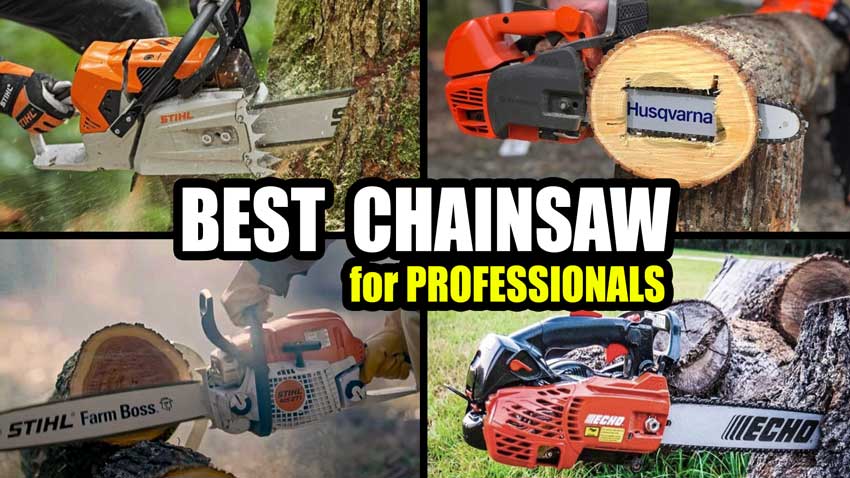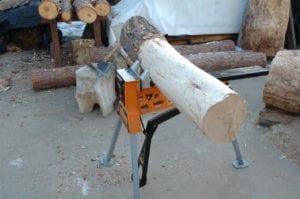Having extensively reported on the best battery chainsaw via dozens of hands-on reviews, I wanted to specifically recommend some products to Pros. The best professional chainsaws provide a higher level of power and pro-level features for those who use these tools to make a living. This includes professional arborists, tree cutters, foresters, landscape professionals, and more.
Having used, tested, and reviewed dozens of the top models, here are my top choices for the best professional chainsaws across several specific applications.
Best Professional Chainsaws – Our Top Picks
- Best Overall: Stihl MS 500i Chainsaw with EFI – Buy at Acme Tools
Jump to this Chainsaw ↓ - Best Top Handle: Echo DCS-2500T – Buy at Acme Tools
Jump to this Chainsaw ↓ - Best 50cc: MS 261 C-M – Buy at Acme Tools
Jump to this Chainsaw ↓ - Best 60cc: Echo CS-590 Timber Wolf – Buy on Amazon
Jump to this Chainsaw ↓ - Best for Long Bars: Stihl MS 881 Magnum – Shop at Stihl
Jump to this Chainsaw ↓ - Best for Firewood: Husqvarna 455 Rancher – Buy on Amazon
Jump to this Chainsaw ↓ - Best Battery: Husqvarna 540i XP – Buy at Acme Tools
Jump to this Chainsaw ↓ - Best Pro Chain: Stihl Rapid Micro Comfort 3 – Buy at Amazon
Jump to this Chain ↓
Also in this Article
- Best-Selling Chainsaws
- How We Test Pro Chainsaws
- Features We Look For
- A Word on Chainsaw Ergonomics
- Why You Can Trust Pro Tool Reviews
Related Content
Best Professional Chainsaw Overall
Stihl MS 500i Chainsaw with EFI
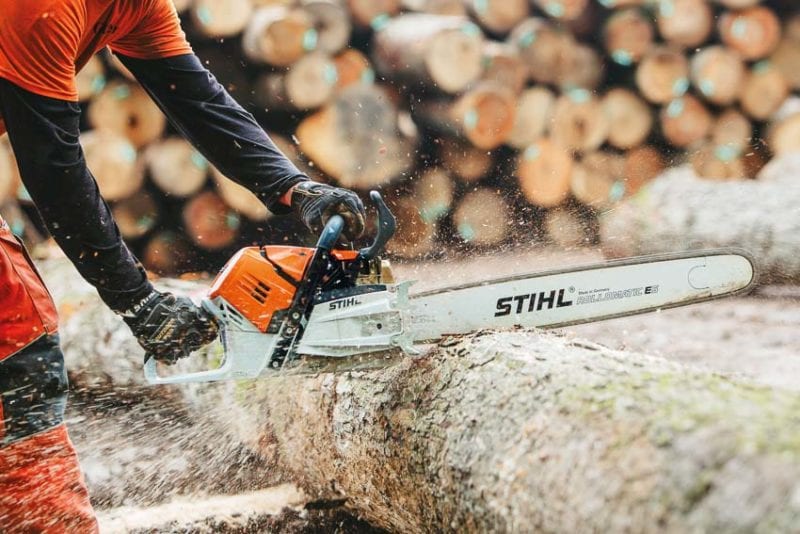
Pros
- Electronic fuel injection provides quick acceleration
- Excellent power-to-weight ratio
Cons
- More expensive than non-EFI models
The Stihl MS 500i chainsaw provides a ton of power for cutting trees. It also has stupid-quick acceleration — going from 0-62mph in a quarter second. That’s very important so forestry and tree service professionals don’t waste their time. The 79.2cc (4.83 cu. in.) engine features an electronic fuel injector. Stihl also uses this technology on its TS 500i 14-inch brushless cut-off saw (I love that tool as well!). While it provides some advanced technology, the Stihl MS 500i does so without overcomplicating things or increasing maintenance costs or requirements.
When using the MS 500i, you quickly realize the power and cutting speed of this saw—even across larger-diameter trees and branches. The long bucking spikes are expected, but the power and speed made it easy for me to get in and pivot through cuts with ease.
Pushing 6.7 bhp and weighing 13.9 lbs. without fuel, the Stihl MS 500i saw also has an excellent power-to-weight ratio. A chainsaw with no choke? I’ll take it. Priced at around $1,599, I imagine you can use this chainsaw for well over a decade if you take care of it.
Best Lightweight Top Handle Professional Chainsaw
Echo DCS-2500T Top Handle Chainsaw
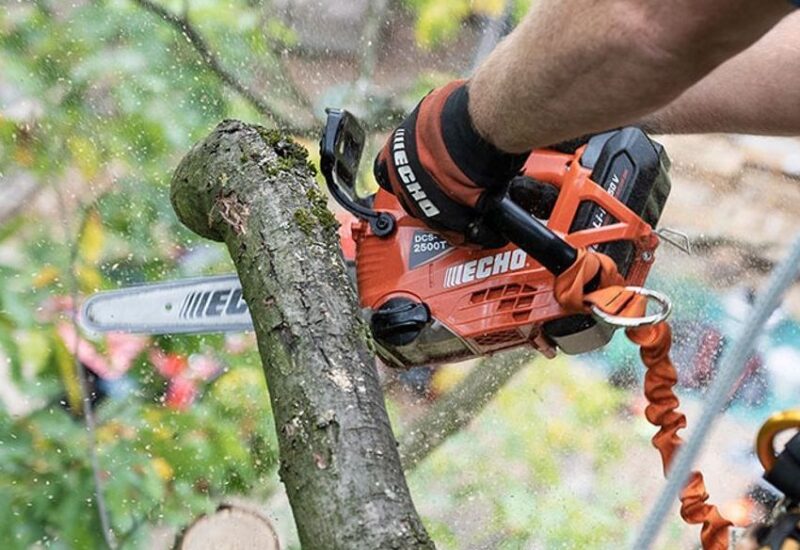
Pros
- The very best power-to-weight ratio
- Super-nimble
Cons
- Less runtime than gas unless you rotate batteries
At first glance, I thought the Echo DCS-2500T top-handle chainsaw looked like a toy. After getting my hands on it, however, I realized this chainsaw was the real deal. I used it to remove 4–8″ limbs — which it did without breaking a sweat. I even tested it on a larger oak tree that I needed to attack from both sides. The main feature of this saw concerns its quick ramp-up and nimble handling. As a climbing saw, it can’t be beat.
Paired with a 2.5Ah battery, this 12-inch chainsaw lets you climb and cut without the hassles of noise. You also have no pull-starts – starting and stopping are instantaneous. Additionally, this saw makes it much easier to communicate with your partner on the ground. Other Pro features I like include the adjustable top-mounted oiler, flip-top oil cap, and removable debris screen. A side chain tension adjustment with retained nut also helps when you need to do an onsite swap-out of the chain.
I doubt you’ll find a better mix of power and portability for climbing. My best lightweight top-handle chainsaw pick retails for around $660 as a kit with a 2.5Ah battery and charger. Expect around 60 small cuts per charge. Grab a second battery for near-continuous operation.
Best 50cc Professional Chainsaw
Stihl MS 261 C-M Chainsaw
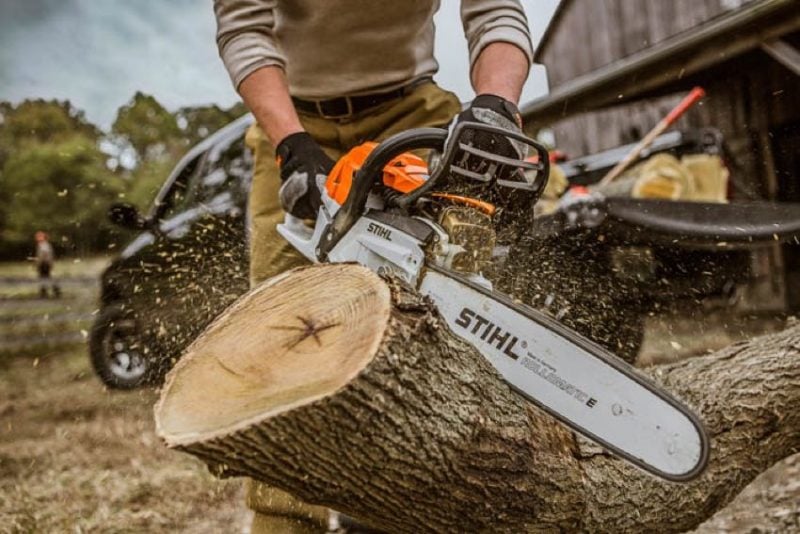
Pros
- Maintains speed under load
- Automatic fuel mix maintains performance and prevents stalling
Cons
- M-Tronic technology adds significantly to the price
Stihl makes its MS 261 C-M chainsaw in Virginia Beach. The MS 261 C-M mirrors the fuel efficiency and low exhaust features of the MS 261 but adds Stihl’s M-Tronic engine management system. This system uses a small computer to monitor and automatically adjust the fuel mix to deal with things like elevation, temperature, fuel quality, and (my favorite) dirty air filters. The saw overcomes most issues that would cause a lesser chainsaw to stall out.
When testing the MS 261 C-M, I found it amazingly powerful. It maintained a majority of its chain speed even when in the midst of a tough cut on thicker logs. The saw also makes it simple to change the chain in the field — as you might expect. Auto oiling also worked well and kept the chain perfectly lubricated throughout the day.
This saw retails for around $680 at several online retailers.
Best 60cc Professional Chainsaw
Echo CS-590 Timber Wolf 60cc Chainsaw
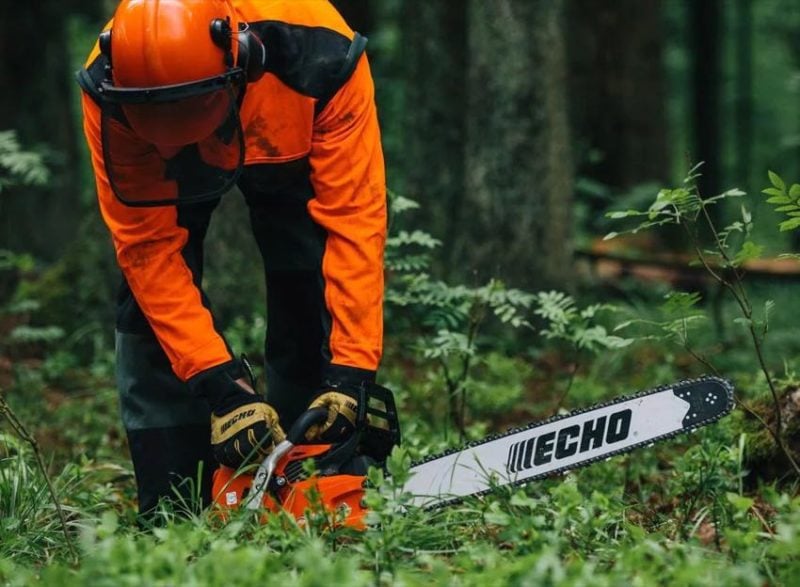
Pros
- Easy one-pull starting
- Excellent long-term performance
Cons
- None at this price
I tested the Echo Timber Wolf CS-590 chainsaw on everything from removing stumps to cutting pole barn beams in half. The saw starts easily on the first pull and without any hesitation. More importantly, it remained easy to start from the first pull until the tool was over 7 years “young”. This tool even got run over by a large dump truck at one point, pushing it deep into the dirt. It broke the handle, but the saw still started up!
The 59.8 cc motor cuts smoothly and powerfully with an ease that makes it feel like a larger professional chainsaw. There was more than enough torque and no kickback whatsoever. The balance and weight of this saw work with you rather than against you. I’ve used more powerful saws, but none that feel quite as well-balanced in the hand. At around $450 this saw won’t come up against much it can’t handle. Decide on your preferred bar size (18-, 20-, or 24-inches) and pick one up.
Editor’s Note: We can’t help but also mention the much larger Stihl MS 661 Magnum Series. These saws cost considerably more ($1280 to $1330), but we find them incredibly powerful and flexible. You can get them with bar sizes from 16- to 32-inches so they pick up where the Timber Wolf leaves off.
Best Professional Chainsaw for Long Bars
Stihl MS 881 Magnum Chainsaw (up to 41″ bar)
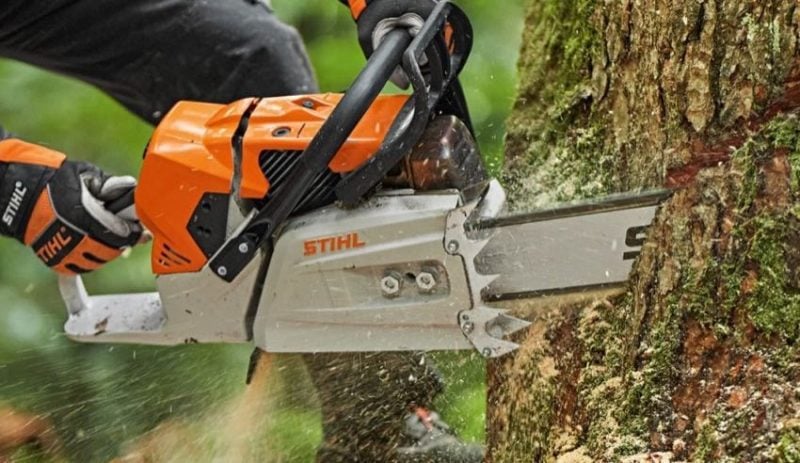
Pros
- Unmatched power for larger cuts
Cons
- Expensive
Can you find a chainsaw with a larger bar and more power? Sure, but the Stihl MS 881 Magnum chainsaw is currently the largest Stihl offers. It directly replaces the well-regarded MS 880 and reduces emissions. This saw boasts a 121.6cc engine and support for a 41-inch bar. While the MS 880 supported a bar up to 59 inches in length, Stihl no longer seems to offer that as a stock or build-to-order option. A quick conversation with your local Stihl dealer will help you understand your options.
From forestry to logging or milling, this saw brings both power and control. You can grab it for around $2020.
Best Professional Chainsaw for Cutting Firewood
Husqvarna 455 Rancher Chainsaw
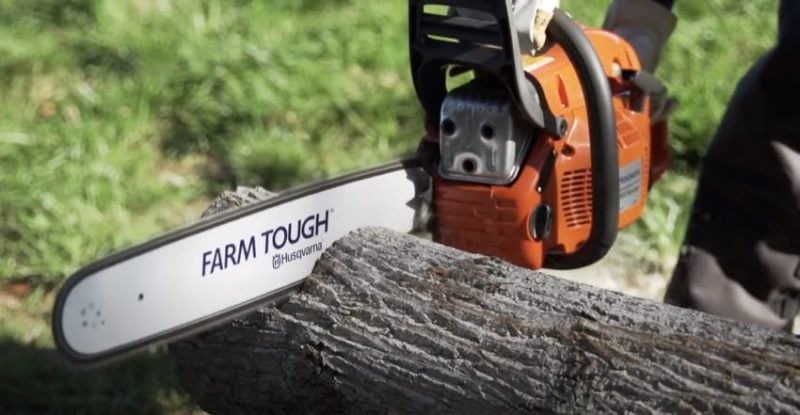
Pros
- Exceptional value and performance
- Low vibration
Cons
- None at this price
I love the Husqvarna 455 Rancher for its combination of power and value. You can pay a little more for the 545 Mark II or a LOT more for the Husqvarna 562 XP G Mark II with heated handles. I honestly don’t think it makes sense since it trades off some engine size for Autotune and a magnesium crankcase. The 455 Rancher gives me a low-vibration 55cc saw that cuts through firewood like butter.
I prefer the stock 20-inch blade as a great size for cutting all manner of firewood. I didn’t find it intrusive when cutting smaller wood. The chain tension adjusts quickly and easily using a single screw, and changing the air filter requires no tools. Retailing at $500, I can easily call this the best professional chainsaw for cutting firewood. It will serve you for years and start up every time provided you take good care of it.
Best Professional Electric (Battery-Powered) Chainsaw
Husqvarna 540i XP
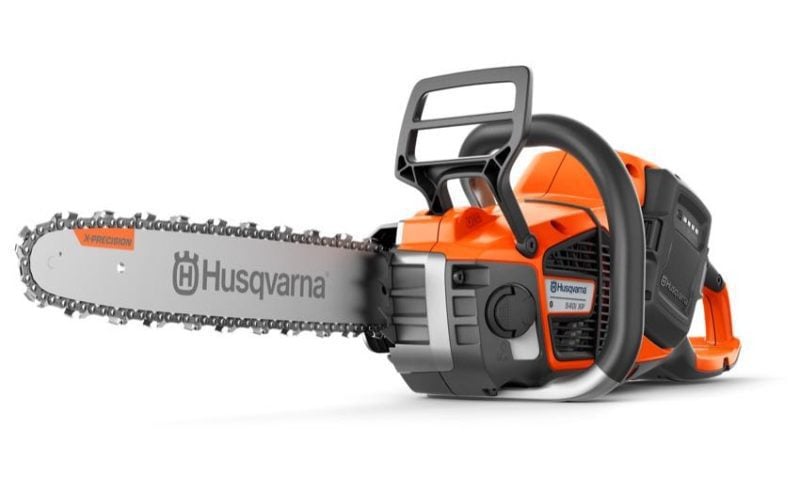
Pros
- Quick acceleration
- 40cc power
Cons
- Less runtime than gas unless you cycle batteries
When it comes to battery-powered chainsaws, Pros have more options than ever before. Professional OPE brands Stihl and Husqvarna make outstanding saws while cordless powerhouses such as Makita and Milwaukee have also produced legitimate options. Still, when it comes to recommending an electric or battery-powered chainsaw for professionals, I lean toward brands with more experienced dealer support.
In the end, I chose Husqvarna’s 540i XP as the best battery-powered chainsaw for professionals. Though not as powerful as the Greenworks Commercial 82V, its balance of 40cc power and weight makes it an excellent all-rounder for gas-free tree cutting. It starts up nearly instantly and has plenty of power.
While I don’t anticipate this as a primary usage case, I do like that you can swap the standard battery pack for a battery backpack. If you need extended cutting time on the ground, this gives you a means to do it without going through 4-5 batteries.
Price: $800 bare (18-inch bar), $610 bare (16-inch bar), $960 (kit w/9.4Ah battery)
Other Professional Battery-Powered Chainsaws I Recommend:
- Stihl MSA 220 C-B 36V 16-inch Chainsaw: Solid design and increased power backed by Stihl’s dealer network
- Makita XCU04 18V X2 (36V) 16-inch Chainsaw: Smooth-cutting and powerful with a wide range of compatible OPE ($299 bare, $390 with 2 batteries and charger)
- Milwaukee 2727 M18 Fuel 16-inch Chainsaw: 40cc gas performance with a 12.0Ah power source available ($329 bare, $499 with 12.0Ah battery and charger)
Best Professional Chainsaw Chain
Stihl Chainsaw Chain
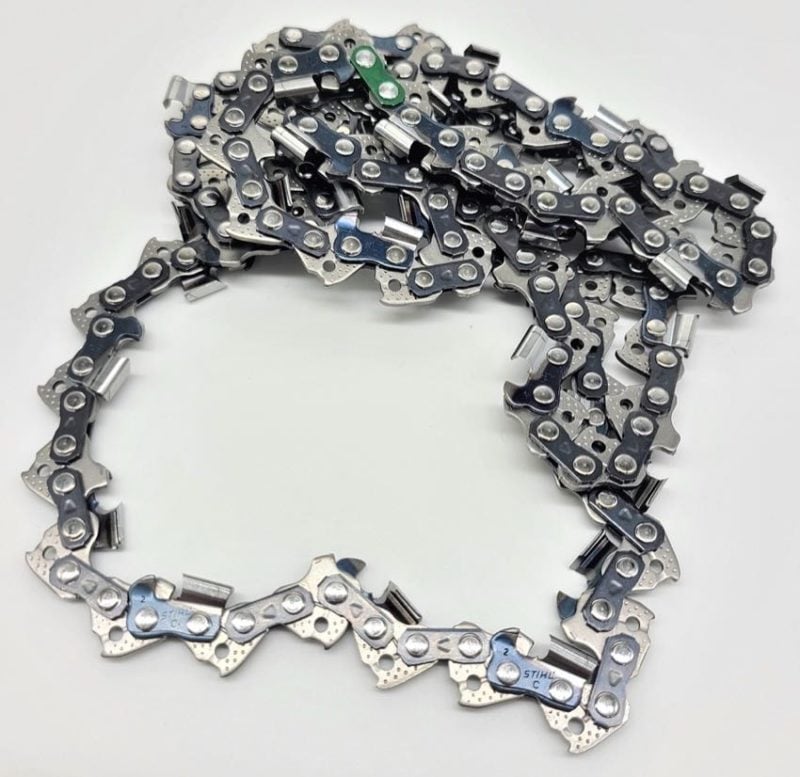
Stihl is the only chainsaw manufacturer that produces its own guide bars and saw chains. They have a guide bar facility in Waiblingen, Germany, and manufacture saw chains in Switzerland. They also manufacture products in their 83-acre Virginia Beach campus. Longer Stihl Rollomatic E Super Guide Bars feature an angled oil delivery hole that improves oil flow to the saw chain. All Stihl chains are pre-stretched before they leave the factory.
I can’t recommend a single chain for everyone. Too many variables change depending on your goals. Stihl has over a dozen different chain types if that’s any indication of how many options you have. If you don’t know anything, start with the Stihl Rapid Micro Comfort 3 chain. It combines low chatter and reduced kickback with smooth cutting and low vibration. Their Pico Duro chain features carbide-tipped technology and stays sharper longer.
Choose one of their Rapid Micro skip-tooth blades if you want more speed and fewer teeth for sharpening. This is my favorite chain for basic tree felling.
Best-Selling Chainsaws
When it comes to professional chainsaws, you may be best served by hitting up your local dealer. Still, if you want to comparison shop online—Pro Tool Reviews has you covered! You certainly have plenty of models to choose from out there. Absent are the truly professional chainsaws with longer bars. Many of those models are only sold via dealers at physical stores. Here’s what others are buying from leading retailers.
Amazon
- DeWalt DCCS620B 20V XR 12-Inch Chainsaw – $154
- Oregon CS1500 18-inch 15 Amp (corded) – $80
- Greenworks 40V 12″ Cordless Compact Chainsaw – $120
Acme Tools
- DeWalt FLEXVOLT 60V Brushless 20-inch Chainsaw Kit – $549
- EGO CS1613 16-inch Chain Saw Kit – $299
- Milwaukee 2727-21HD M18 FUEL 16 in Chainsaw Kit – $499
Lowe’s
- Craftsman CMCCS610D1 V20 10-in Battery Chainsaw Kit – $149
- EGO CS1804 56V 18-in Brushless Chainsaw Kit – $399
- Kobalt KCS 1224A-03 24V 12-in Brushless Chainsaw Kit – $189
Home Depot
- ECHO 20 in 59.8cc 2-Stroke Rear Handle Timber Wolf – $449
- DeWalt DCCS620P1 20V MAX 12-in Brushless Chainsaw Kit – $249
- Milwaukee 2727-20 M18 FUEL 16-in Brushless Chainsaw – $329
How We Test Professional Chainsaws
Over years of testing, I and the folks at Pro Tool Reviews have made many thousands of cuts through pine, cedar, oaks, and much more. These range from limbing small branches through felling 3-foot diameter trees, and digging out after hurricanes. When possible, I prefer testing chainsaws by crosscutting in green (wet) wood like these chains were designed for, not in dried construction lumber.
Chainsaw Cutting Power
The size of the motor determines a good amount of the power potential of a saw, but hands-on testing matters the most. Some specifications state cubic centimeters (cc) while others specify cubic inches (I’m looking at you, Husqvarna!). In either case, my recommendations come from either personal use of these saws by myself or our team of Pros. We also spend countless hours interviewing professionals who give us feedback on their typical uses and experiences.
We also see power helped by smart systems that monitor fuel/oxygen levels and keep saws running strong even when filters get clogged from use. For this reason, some 55cc saws can outperform other brands with larger engines once the work gets underway.
The combination of real-world and controlled scenario cutting helps put each saw through its paces.
Matching Chains to Reduce Bias
When doing head-to-head testing of chainsaws, we match the chains across all saws to ensure we aren’t biased by comparing saws using different types of chains. You’ll find the same differences in your own use depending on what type of chain you choose. Chain type affects the speed of the cut (perceived power) as well as chip clearing, vibration, and the potential for kickback.
The Best Professional Chainsaw Features We Look For
Triggers
Unlike battery-powered Pro chainsaws, professional gas chainsaws use a throttle and clutch to operate. For the most part, you either let a chainsaw idle or run it at full throttle. You might feather the throttle a little for small climbing actions, but in general, I want a trigger that feels responsive and comfortable to pull and use.
Ease of Starting
Professional chainsaws—for the most part—use two-cycle fuel. That means pull-starting them. If a chainsaw starts slowly or requires a drawn-out process to start, I take a hard pass. For the most part, professionals don’t have issues with these saws starting up quickly. For those who need to ramp up and down without missing a beat, however, some of the EFI options present a nice solution—albeit one that costs more money.
Chain Adjustment
Chainsaw bars need to be adjusted nearly every time you use the saw. A new chain stretches out pretty quickly. You need to snug it up at least a few times as it breaks in.
If your chain gets tight rather suddenly, it usually means the bar is not getting oil. Don’t loosen it until you make sure the saw is oiling properly.
Pro Tip: Get into the habit of loosening your chain at the end of the day. Cold weather can cause it to tighten as it cools and damage parts.
Professional chainsaw bars require a screwdriver-wrench combination tool called a scrench. None of our Pro recommendations feature tool-free tensioners—professionals don’t like them and neither do we for this type of use. They don’t tend to work as well or hold up over the long term.
Don’t Lose Your Nuts!
Lost bar nuts are a frequent occurrence during regular use in the field. To prevent this, some saws have the added feature of captive (retained) nuts that won’t fall off the saw when you loosen them. Several Stihl and Husqvarna chainsaws feature these while Echo tends to skip this handy feature. We always keep a few screnches in the truck and/or trailer.
Pro Tip: Keep a spare nut on hand as it’s not unusual to lose one in the field.
Bars and Chains
Most chainsaw brands don’t try to reinvent the wheel by making their own bars and chains. Except for Stihl, that is—who make their own. Other brands typically use an Oregon bar and chain. Most of the chainsaws I test use 3/8″ pitch, 0.050″ gauge chains. Some other saws might opt for “faster” .325-inch pitch chains.
Oiling Systems
Bar and chain oil is the lifeblood of a professional chainsaw. Your saw won’t last very long without it. Throughout my testing, most of the saws oiled readily, and I appreciated any saws with features to prevent or limit leaks.
I also checked oil visibility. For the most part, Pros just maintain a regular schedule for oiling. Even the best translucent oil windows quickly get dirty quickly—making it difficult to use them for their intended purpose. This goes double for the ones that look like they were an afterthought—far too small to be practical.
Ease of Filling Matters
Since I frequently add oil to my professional chainsaws, the size of the oil reservoir and the ease of adding new oil matters. It makes a regular task much easier. I don’t like having oily fingers, so being able to fill the tank while leaving my work gloves on is my preference. Look for oil caps with lugs that are easy to turn with gloves on and/or flip-up tabs that provide an even better grip.
Spills & More Spills
Another cause of spills in professional chainsaws is an oil tank with a filler neck that is too narrow. Bar and chain oil is thick and tacky. It can pour like molasses in the cold, so it easily “piles up” and overflows in a narrow neck.
While filling most chainsaws proves passable, some designs have a narrow neck or sit at an angle that makes the target even smaller.
Providing another challenge, plastic filters at the inlet of its tank can constrict the diameter. Finally, caps that cross-thread easily can also make the oil-fill process more of a chore.
Tips to Avoid Leaking or Spilling Oil
Here’s a tip—only poke a little hole in the foil sealing your quart or gallon oil bottle so you can pour a skinny stream. Or dispense your oil from a syrup bottle that has a tapered, pull-to-open tip. It works like a charm, and you can push the tip against the inside of the filler neck to stop the flow for one-handed control when your other hand is steadying the saw.
Just make sure you clean out the bottle first (you may have to eat a whole lot of pancakes).
Chainsaws often leak oil while sitting because daily heating and cooling shrinks and expands a plastic tank like a rudimentary pump. Some saws are messier than others.
Chain Brake and Other Safety Features
I want an easy-to-use chain brake that works well. Most manufacturers have this down to a science at this point, so I encounter very few issues here. Most extend high enough to offer easy activation during a kickback event.
I want a safety trigger lock that’s easy to use without getting in the way. Stihl, Husqvarna, and Echo put theirs on the back of the handle. These work well—until they don’t. For the most part, I’m simply looking for placement and feel—ensuring I don’t have to move my hand from a natural position when grasping the saw to use it. Notably, Echo provides the easiest-to-replace trigger lock…I’m not sure if that’s a good or bad sign.
I also check the chain catch pin and position of the hand guards—but most manufacturers have this down to a science.
For more on safety, explore our guide to Chainsaw Safety Rules for Beginners and Pros!
Bucking Spikes
For pushing a saw through wood more efficiently, chainsaws come fitted with bucking spikes (a.k.a. bumper spikes, felling spikes, or dogs). These spikes sit against the body of the saw alongside the bar and anchor the saw in place while the bar pivots through the cut.
The spikes allow you to apply a lifting motion of the rear hand instead of pushing downward. Holding the saw tight to the wood, the motor can exert its maximum pulling power. This saves you from some of the cutting vibrations and especially the jerking common to holding a saw away from your work.
Applying leverage with spikes adds control, but go easy and listen to the pitch of the motor. You can stall even a gas chainsaw by applying too much pressure.
A Word About Chainsaw Ergonomics
Balance
While it’s true that the comfort and feel of a tool are largely subjective, it’s also true that some designs work better than others. Most Pros and experienced homeowners can immediately tell. I believe that thoughtful design intention and execution do come through for the majority of users.
The best professional chainsaws will feel balanced in your hands. It should cut straight without introducing a twisting motion and you should not feel like either the back hand or your front grip is overly stressed when cutting. You want to be able to easily rock the saw forward and back on the bucking spikes when cutting through larger trunks.
Holding a saw with your left hand on the front handle in front of you should have the saw balanced fairly flat. Being a bit front-heavy is okay, but a rear-heavy saw lifts the cutting end of the saw up toward you and requires more effort and vigilance to use and carry safely.
Cutting Sideways
Determining a good feel for felling cuts while holding the chainsaw sideways is more about the comfort of applying force to the front and rear handles as you grasp it from the side, and also the ease of operating the trigger while sideways. I try and test all directions when using both top-handle and rear-handle saws
Handles
In general, chainsaws with thicker handles are more comfortable to grasp in use because their broader radiused edges serve to soften the contact with your hand. Of course, rubber handle surfaces help too, not only for padding but also for the increased grip they provide.
In actuality, it’s remarkable just how similar the grip is on Stihl, Husqvarna, and Echo professional chainsaws. Husqvarna provides little to no rubber overmold. Echo gives you some texture on the side of their plastic handle. Stihl gives some overmold on the back, which I like.
They and Husqvarna also provide a stop to keep you from sliding up in the decoupled portion of the handle where the vibration control occurs. On an Echo chainsaw, they decouple a larger portion of the rear handle to control vibration.
Trigger Comfort
Most professional chainsaw triggers are large enough for two fingers to fit on them. Some have an extra-long trigger with more room to vary your grip stance for comfort. The best feeling triggers retract flush with the handle instead of leaving a raised bump your fingers have to push against.
Weight
The dry weight of the best professional chainsaws can be as low as 6 pounds to well over 16 pounds. Experience shows that a saw’s weight is less important than proper balance overall as you only feel the full weight when you’re NOT cutting.
Why You Can Trust Pro Tool Reviews
Ever check out a “review” site and you can’t tell if they actually tested the tools or if they’re just “recommending” the Amazon top sellers?
That’s not us. We only recommend what we’d actually use, even if we don’t earn a commission from it. It’s all about giving you a legitimate recommendation and our honest opinion of each product.
We’ve been in business since 2008 covering tools, writing reviews, and reporting on industry news in the construction, automotive, and lawn care industries. Our Pro reviewers work in the trades and have the skills and experience to know whether tools can perform well in the field.
Each year, we bring in and review more than 250 individual products. Our team will put our hands on hundreds of additional tools at media events and trade shows throughout the year.
We consult with innovators in the technology and design of tools to gain a broader grasp of where these products fit and how they work.
We work with more than two dozen professional contractors around the United States who review products for us on real job sites and consult with us on testing methods, categories, and weighting.
We’ll provide more than 500 pieces of new content this year absolutely free for our readers—including objective evaluations of individual tools and products.
The end result is information you can trust because of the editorial, scientific, and real-world professional experience we collectively utilize each and every time we pick up and test a tool.

